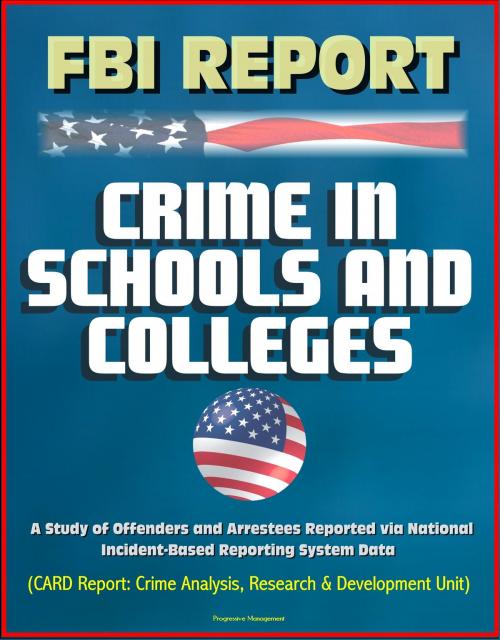FBI Report: Crime in Schools and Colleges: A Study of Offenders and Arrestees Reported via National Incident-Based Reporting System Data
Nonfiction, Reference & Language, Education & Teaching, Administration, Social & Cultural Studies, True Crime| Author: | Progressive Management | ISBN: | 9781301448432 |
| Publisher: | Progressive Management | Publication: | April 12, 2013 |
| Imprint: | Smashwords Edition | Language: | English |
| Author: | Progressive Management |
| ISBN: | 9781301448432 |
| Publisher: | Progressive Management |
| Publication: | April 12, 2013 |
| Imprint: | Smashwords Edition |
| Language: | English |
Schools and colleges are valued institutions that help build upon the Nation's foundations and serve as an arena where the growth and stability of future generations begin. Crime in schools and colleges is therefore one of the most troublesome social problems in the Nation today. Not only does it affect those involved in the criminal incident, but it also hinders societal growth and stability. In that light, it is vital to understand the characteristics surrounding crime in schools, colleges, and universities and the offenders who reportedly commit these offenses so that law enforcement, policy makers, school administrators, and the public can properly combat and reduce the amount of crime occurring at these institutions.
Tremendous resources have been used to develop a myriad of federal and nonfederal studies that focus on identifying the characteristics surrounding violent crime, property crime, and/or crimes against society in schools. The objective of such studies is to identify and measure the crime problem facing the Nation's more than 90,000 schools and the nearly 50 million students in attendance. The findings of these studies have generated significant debates surrounding the actual levels of violent and nonviolent crimes and the need for preventative policies. Some research indicates there has been an increase in school violence activities, such as a study from the School Violence Resource Center which showed that the percentage of high school students who were threatened or injured with a weapon increased from 1993 to 2001.
Situations surrounding crime at school locations vary based on the offender's motive and the intended victim. For example, incidents involving student offenders and student victims constitute the stereotypical definition of crime at schools, colleges, and universities where the offender and victim are present to participate in the activities occurring at the institution. However, there are situations involving adult and/or juvenile offenders and victims, where the school serves only as an offense location because neither the offender nor the victim is present to participate in school functions. Criminal acts due to political motivation, hate crimes, and crimes perpetrated by offenders against victims who are not instructors or students and have no other relation to the school are examples of such situations.
In an attempt to shed light on crime in schools, colleges, and universities, this study used incident-based crime data the FBI received from a limited set of law enforcement agencies through the UCR Program. Some of the findings are perhaps contrary to popular perceptions; for example, over the 5-year study period, the use of knives/cutting instruments was over three times more prevalent than the use of a gun. Other findings reflect conventional wisdom; for example, males were nearly 3.6 times more likely to be arrested for crime in schools and colleges than females.
Schools and colleges are valued institutions that help build upon the Nation's foundations and serve as an arena where the growth and stability of future generations begin. Crime in schools and colleges is therefore one of the most troublesome social problems in the Nation today. Not only does it affect those involved in the criminal incident, but it also hinders societal growth and stability. In that light, it is vital to understand the characteristics surrounding crime in schools, colleges, and universities and the offenders who reportedly commit these offenses so that law enforcement, policy makers, school administrators, and the public can properly combat and reduce the amount of crime occurring at these institutions.
Tremendous resources have been used to develop a myriad of federal and nonfederal studies that focus on identifying the characteristics surrounding violent crime, property crime, and/or crimes against society in schools. The objective of such studies is to identify and measure the crime problem facing the Nation's more than 90,000 schools and the nearly 50 million students in attendance. The findings of these studies have generated significant debates surrounding the actual levels of violent and nonviolent crimes and the need for preventative policies. Some research indicates there has been an increase in school violence activities, such as a study from the School Violence Resource Center which showed that the percentage of high school students who were threatened or injured with a weapon increased from 1993 to 2001.
Situations surrounding crime at school locations vary based on the offender's motive and the intended victim. For example, incidents involving student offenders and student victims constitute the stereotypical definition of crime at schools, colleges, and universities where the offender and victim are present to participate in the activities occurring at the institution. However, there are situations involving adult and/or juvenile offenders and victims, where the school serves only as an offense location because neither the offender nor the victim is present to participate in school functions. Criminal acts due to political motivation, hate crimes, and crimes perpetrated by offenders against victims who are not instructors or students and have no other relation to the school are examples of such situations.
In an attempt to shed light on crime in schools, colleges, and universities, this study used incident-based crime data the FBI received from a limited set of law enforcement agencies through the UCR Program. Some of the findings are perhaps contrary to popular perceptions; for example, over the 5-year study period, the use of knives/cutting instruments was over three times more prevalent than the use of a gun. Other findings reflect conventional wisdom; for example, males were nearly 3.6 times more likely to be arrested for crime in schools and colleges than females.















